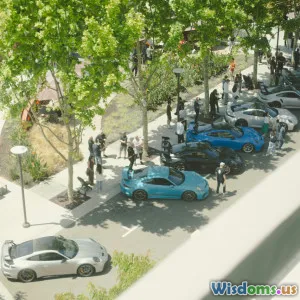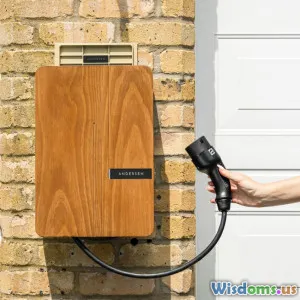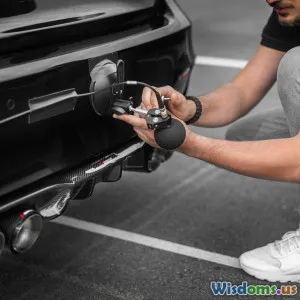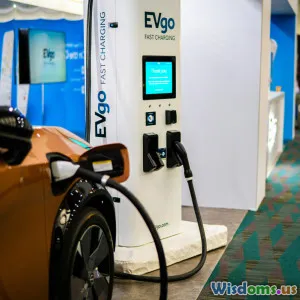
What Autonomous Parking Means for City Drivers in 2024
17 min read Explore how autonomous parking is transforming the city driving experience in 2024, improving convenience, safety, and urban mobility. (0 Reviews)
What Autonomous Parking Means for City Drivers in 2024
Finding a parking spot in the heart of the city has long been the bane of urban driving—with stress, delays, and even fender-benders all too common. Enter autonomous parking: a technological evolution positioning itself as a quiet game-changer for city dwellers. In 2024, the impact is no longer speculative; it's tangible, reshaping not only how drivers experience urban mobility but how cities think about space and efficiency. Let’s explore how this cutting-edge technology is altering the rhythm and reality of daily commuting, why it matters, and what drivers need to know.
Autonomous Parking: How Does It Really Work?

Autonomous parking, sometimes dubbed "automated valet parking," is where your car does all the hard work of finding and slotting itself into a parking space—without human intervention. Most modern autonomous vehicles (AVs) and high-end models from brands like Tesla, Mercedes-Benz, and BMW now feature variants of this technology.
The Technology Under the Hood
Autonomous parking relies on a blend of advanced sensors (lidar, radar, ultrasonic), real-time mapping, AI algorithms, and an array of cameras. These allow the vehicle to sense obstacles, recognize parking lines, and handle maneuvering with surgical precision. With vehicle-to-infrastructure (V2I) communication—thanks to connected garages and smart cities—the process is now enhanced to integrate real-time parking occupancy data and reservation features.
For instance, the Mercedes-Benz S-Class equipped with the Intelligent Park Pilot will drop you at a terminal and self-drive to the nearest suitable space. BMW's Remote Control Parking allows users to initiate parking sequences via a smartphone while standing outside. These features are not for distant futures: by 2024, urban drivers in cities like San Francisco, Munich, and Tokyo are leveraging them every day.
The Urban Parking Challenge

Consider this: According to a 2023 INRIX study, the average urban driver spends nearly 17 hours annually just searching for parking—contributing to fuel waste, pollution, and stress. In dense areas like Manhattan, parking scarcity can inflate prices to more than $600 a month, while cruising for parking can constitute 30% of downtown traffic.
Autonomous parking sticks a wrench in these patterns. Rather than circling endlessly for that elusive open spot, drivers can use apps to drop off their car and let it park itself. Cities like Stuttgart and San José have piloted smart parking zones where drop-off points work like mini staging areas. Drivers can step out, attend to their tasks, and the car navigates to a remote or robotic lot.
This redirection not only slashes window-shopping for parking but also reduces speculative traffic jams and cuts urban emissions. In Tokyo, fleet management AVs are being trialed to reduce queueing chaos during peak commute hours, while London’s "Park and Go" AI pilot led to a reported 12% drop in city-center vehicular congestion after initial deployment.
Comparing Autonomous Parking Modes: Self-Parking vs. Automated Valet

Autonomous parking in 2024 takes two primary forms:
Self-Parking Assistance
Here, drivers remain partly engaged—overseeing and confirming parking. Think Tesla’s "Smart Summon" or Hyundai’s "Remote Smart Parking Assist," where the driver controls parking via an app from outside the car. These solutions work best in private lots or home driveways and are less reliant on smart infrastructure.
Example: Jane pulls into a crowded grocery store lot, steps out, and from her app, directs her Hyundai Sonata to slip into a tight parallel spot. The car scans the environment, reverses, and swings perfectly into position.
Full Automated Valet Parking
This more advanced solution requires infrastructure cooperation like sensors within the garage and V2I connectivity. Here, a driver leaves the car at a drop-off point—the vehicle determines a spot, drives itself, and secures the space, then returns when summoned.
Example: At Detroit’s City Center Garage, participating drivers activate the automated valet feature. The car is dropped in a designated handover zone, then receives instructions from the garage’s smart system to find an optimal space. Algorithms balance vehicle distribution for maximum lot usage.
Compare the convenience: self-parking shines in smaller or older lots where smart infrastructure isn't feasible; full valet automation flourishes where cities are investing in IoT-enabled parking hubs, representing the next leap in convenience for city drivers.
Making Parking Smarter, Not Just Easier

Smart parking infrastructure is more than a tech artifact—it's a catalyst for urban change. The symbiosis between vehicles and city infrastructure is yielding features unimaginable in previous decades:
- Real-time Space Availability: Digital signage and vehicle dashboards show live availability, reducing guesswork.
- Reservation & Payment Integration: Apps like ParkWhiz are now building APIs for AV platforms. Drivers can reserve a spot ahead of time, pay through the app, and have their car park upon arrival.
- Dynamic Pricing: Next-gen garages implement surge pricing algorithms, optimizing revenue while deterring aimless cruising.
- Optimized Layouts: Without needing to accommodate driver doors opening wide, lots can fit more vehicles, as AVs park with tighter spacing. Some European garages redesigned in 2023 reported up to 20% more cars per lot without compromising safety.
In South Korea’s Songdo smart city district, for example, the entire parking ecosystem operates with RFID-guided robotics, seamlessly adjusting capacity in real-time to passenger numbers at adjacent transit hubs and shopping malls.
Safety, Security, and Liability: Navigating a New Legal Landscape

While automated parking eliminates risky maneuvers, it introduces new technical and legal complexities. City drivers must now consider questions like: Who’s at fault in a low-speed fender-bender between two self-parking cars?
Safety Enhancements
Automated systems excel at slow-speed operations, maintaining control and awareness superior to many distracted drivers. Forward-collision and pedestrian detection generally function regardless of visibility, reducing accidents. The Insurance Institute for Highway Safety (IIHS) in 2023 confirmed autonomous parking systems reduced parking lot collisions by as much as 40% for equipped cars.
Data Security and Privacy
With added connectivity comes vulnerability. Parking systems increasingly handle payment, location, and user profiles—prime targets for hackers. Automakers now encrypt vehicle-to-infrastructure communications, but users must ensure their apps and vehicle software are up-to-date, and public Wi-Fi is avoided during configuration.
Liability Models Shifting
Most insurance companies in the U.S. currently treat Level 2/Level 3 autonomy features as supportive tools—fault is still generally assigned to the owner or operator. By mid-2024, regulators in California and the UK are exploring new liability frameworks as Level 4 features begin piloting in urban fleets, seeking to close the gray area between driver, manufacturer, and third-party infrastructure providers.
The User Experience: Practical Tips for City Drivers

1. Choose the Right Features for Your Needs
Not all autonomous systems are equal. Check whether your prospective car supports:
- Remote smart parking (control via fob/mobile app)
- Full valet drop-off (infrastructure-dependent)
- Integrated service payments (in-car app, app ecosystem compatibility)
Manufacturers will specify which city facilities or lots are compatible with their systems—check regularly, as compatibility lists expand with city-specific collaborations.
2. Prepare for the New Flow
Autonomous parking means adjusting daily habits:
- Scanning for Drop-Zones: Most smart lots require you to drop vehicles within marked lanes.
- App Integration: Link your mobility accounts and set up secure payments.
- Be Patient: Autonomous systems can be a tad slower than ‘parking by feel’—waiting a few extra seconds is the trade-off for a stress-free search.
3. Mind the Updates
Vehicle and app systems are subject to frequent over-the-air (OTA) upgrades for safety and expansion. Enable automatic updates and read release notes—features evolve rapidly, and new capabilities (such as zone expansion or improved obstacle detection) often roll out behind the scenes.
4. Know the Limits
Weather, unclear signage, or construction can confuse even state-of-the-art platforms. Maintain basic parking skills in case manual intervention is needed, and always supervise the process in public, pedestrian-heavy areas until the vehicle confirms completion.
Environmental and Economic Impacts on City Life

The transition to autonomous parking isn’t just making city life smoother—it’s reshaping urban sustainability and budgets.
Reduced Emissions and Road Congestion
Research from MIT’s Urban Mobility Lab indicates autonomous parking reduces vehicle idling and cruising by up to 80%, curbing unnecessary fuel burn. In Los Angeles, early VRU (vulnerable road user) integration into parking AVs led to a measurable drop in emissions hot spots around entertainment venues. The European Environment Agency estimates that if Europe’s top 30 cities adopted full autonomous parking by 2030, CO2 emissions from parking circulation alone could shrink by 250,000 tons annually.
Smarter Space, More Revenue
Parking garages transitioning to AV-only layouts can accommodate more vehicles in the same physical footprint, enabling cities and private operators to boost capacity or repurpose freed-up space for public parks, housing, or new urban services. San Francisco piloted a new downtown garage in 2024 with an autonomous-only floor; initial numbers show a 15% increase in car throughput without new construction, and planners are eyeing conversion of some surface lots to green space.
Lower Driver Costs, Gradually
Based on AAA analysis, city drivers pay a premium for parking scarcity; automated valet programs may initially cost more but are predicted to drive down average parking fees by increasing supply and efficiency. Subscription-based parking and bundled insurance policies for self-parking cars are starting to appear—cutting long-term costs and bundling maintenance.
City Planning and the Future Urban Landscape

Autonomous parking is more than a tech upgrade—it’s steering transformative urban planning shifts.
Repurposing Real Estate
Planners foresee less need for curbside parking and sprawling surface lots as AVs can be stored in compact blocks, often underground or repurposed older garages. Some urban centers—including Hamburg and Seattle—are piloting mixed-use complexes pairing retail, recreation, and AV-stacked parking, reclaiming tens of thousands of square feet for civic use. In Chicago, a 2024 initiative is granting grants for the conversion of outdated parking decks into affordable micro-apartments and rooftop parks.
Seamless Multi-Modal Integration
Autonomous parking dovetails with broader mobility services. Cars can park themselves after dropping passengers at transit stations for last-mile connections or even operate as part of shared fleets, relocating themselves as needed. Stockholm’s 2024 "Mobility Link" program saw car owners earn credits by allowing vehicles to park themselves in outlying areas and shuttle to transit lines, easing inner-city congestion but maintaining driver flexibility.
Challenges Ahead: Equity and Access
As with any rapid innovation, equity lenses are important. Cities must ensure autonomous parking serves broad community interests—developing standards so all car owners, not just the luxury market, access these new conveniences. That means investing in shared infrastructure, subsidizing upgrades for older lots, and maintaining transparency about data use and urban design outcomes.
Autonomous parking isn’t just a feature—it’s the start of a city leveling up. For the millions of city drivers watching parking woes eat into their time and wallets, 2024 is the year that future-facing answers start to arrive.
Rate the Post
User Reviews
Popular Posts














